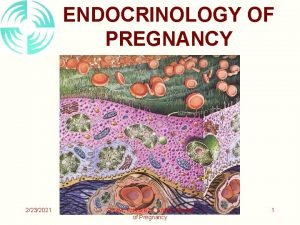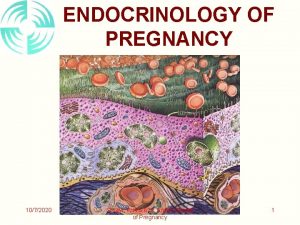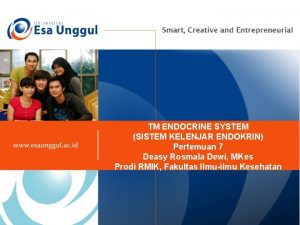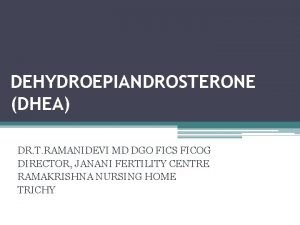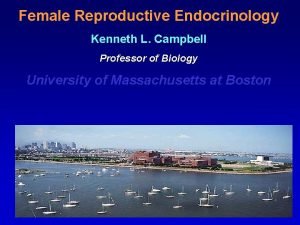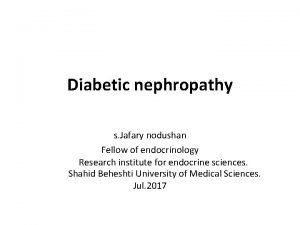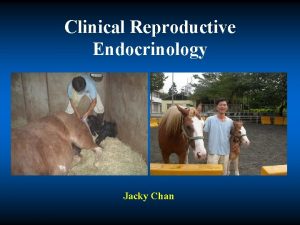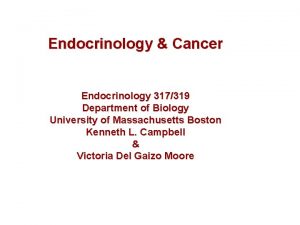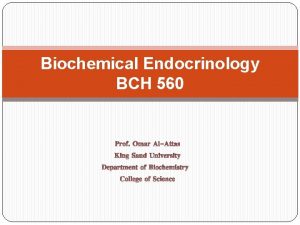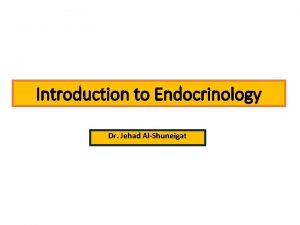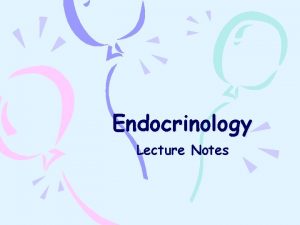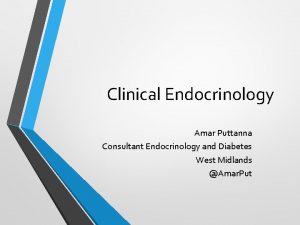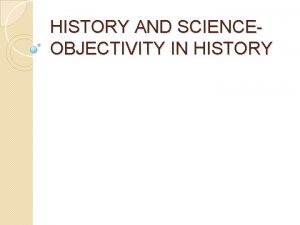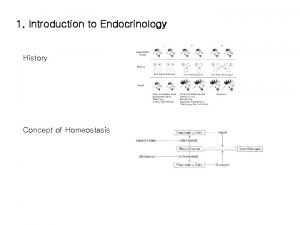The science of endocrinology The history of endocrinology











- Slides: 11

The science of endocrinology The history of endocrinology Ⅰ Modern endocrinologyⅡ

Introduction n Hormone n n Hormao : exiting, setting in motion Endocrine n Endon(within) + krino(to seperate)

Early history n Substitution therapy n Hippocrates(BC 460~357) denied that disease could be caused by the intervention of deities and demons. n John Hunter(1728~1793) had successfully transplanted avian testes. n A. A. Berthold reported the first clear-cut and successful experimant bearing on endocrine gland. n Claude Bernard(1885) showed by chemical methods that the liver could release sugar directly into the blood, and referred to this function as “internal secretion”.

Early history n Brown-Sequard(1889) attempted self-rejuvenation by taking subcutaneous injections of aqueous extracts of dog testes. n Murray(1891) demonstrated that the parenteral administration of a glycerin emulsion of thyroids provided a helpful replacement therapy in human subjects suffering from hypothyroidism. n Baumann(1895) observed a high concentration of iodine in the thyroid gland, the concentration being hundreds of times higher than that of other tissues. • Oliver & Schafer(1895) , demonstrating the vasopressor effects of adrenal extracts, led to the isolation, purification, identification, and final synthesis of epinephrine.

The birth of endocrinology n n Bayliss & Starling(1902 -1905) n Showed the existence & manner of action of the hormone “secretin” n Starling first used the word “hormone” in 1905 n Pende introduced the term “endocrinology” Takamine & Aldrich(1901) n n Succeeded in crystalling epinephrine The twentieth century has seen the isolation and structural identification of a large number of hormones.

The slow growth in infancy n Thyroxine n Gudernatsch(1912) found an extremely potent substance in accelerating the metamorphosis of frogs and salamanders. n n Kendal(1919) obtained pure thyroxine. n Harington(1926) established its chemical constitution. Insuline n Banting and Best(1921) succeeded in preparing highly potent extracts. n Abel(1926) prepared insulin in crystalline form.

The slow growth in infancy n Estrogen n Stockard & Papanicolaou(1917) studied paramount importance in reproductive physiology. n Allen & Doisy(1922) reported that extracts of large follicles of swine ovaries induce estrus changes in the vaginae of castrated mice. n Ascchheim & Zondek(1927) found chorionic gonadotrophin (of placental orgin). n Doisy & Butenandt(1929) succeeded in crystallizing the estronic substance from human pregnancy urine. n Progesterone n Corner & W. M. Allen(1929) prepared extracts of corpora lutea. n Butenandt(1932) determined the pregnanediol, urinary metabolite of progesterone, chemically. n Androgen n Pezard(1911) prepared the first effective extracts of testicular tissue. n Butenandt(1931) extracted crystals of male sex hormone from urine and called androsterone( the degradation product of testosterone).

The slow growth in infancy n n n Cortisol n Swingle & Pfiffner(1930) prepared the first potent extracts. n 20000 cattle/ 1000 kg adrenal gland/ 26 g material/ 300 mg steroid compound. Oxyticin n Aschner(1910) worked out a technique for performing hypophysectomies in dog. n Kamm & Aldrich(1928) succeeded in seperating the oxytocic and vasopressor hormone Prolactin n Stricker & Grueter(1928) indicated clearly that the anterior pituitary is essential for the initiation and maintenance of milk secretion. n White(1937) obtained prolactin in crystalline( the first pituitary hormone to be isolated).

An era of spectacular growth n Hench(1949) cautiously announced that a hormone of adrenal cortex improved some of the clinical and biochemical symptoms. n There were an attempts to manufacture large amount of hormone. n Scientific progress depends upon the introduction of new tools and new methods. n Phase microscope, electron microscope. n Tissue culture techniques. n Radioactive isotope : the biosynthesis, transport, and metabolism of hormone. n Simpson(1953) isolated new adrenal hormone (aldosterone). n Sanga(1954) elucidated the full chemical structure of insulin. n Du Vigneaud(1953) determined the structure of oxytocin and vasopressin.

An era of spectacular growth n n n Glucagon n During the 1920’s most insulin extracts antagonized the action of insulin. n Staub(1955) obtained in crystalline of glucagon. Sulfonanide n Insuln is destroyed by the proteolytic enzyme. n Sulfonamide were effective in reducing blood sugar when taken orally. Applying the techniques of chromatography and radioautography of compounds labeled with I 131, great progress has been made in our understanding of thyroid metabolism. n Von Euler(1949) showed that the transmitter substance, norepinephrine, released by sympathetic nerve terminals.

Method of study n Ablation by surgery or disease n Chemical ablation or impairment n Replacement therapy n Chemical extraction n Isotopic tracer methods n In vitro techniques
 Endocrinology of pregnancy
Endocrinology of pregnancy Endocrinology of pregnancy
Endocrinology of pregnancy Pediatric endocrinology near cameron park
Pediatric endocrinology near cameron park Endocrinology medical term
Endocrinology medical term Reproductive biology and endocrinology
Reproductive biology and endocrinology Reproductive endocrinology near campbell
Reproductive endocrinology near campbell Endocrinology
Endocrinology What is your favourite lesson
What is your favourite lesson Also history physical
Also history physical Hát kết hợp bộ gõ cơ thể
Hát kết hợp bộ gõ cơ thể Slidetodoc
Slidetodoc Bổ thể
Bổ thể
